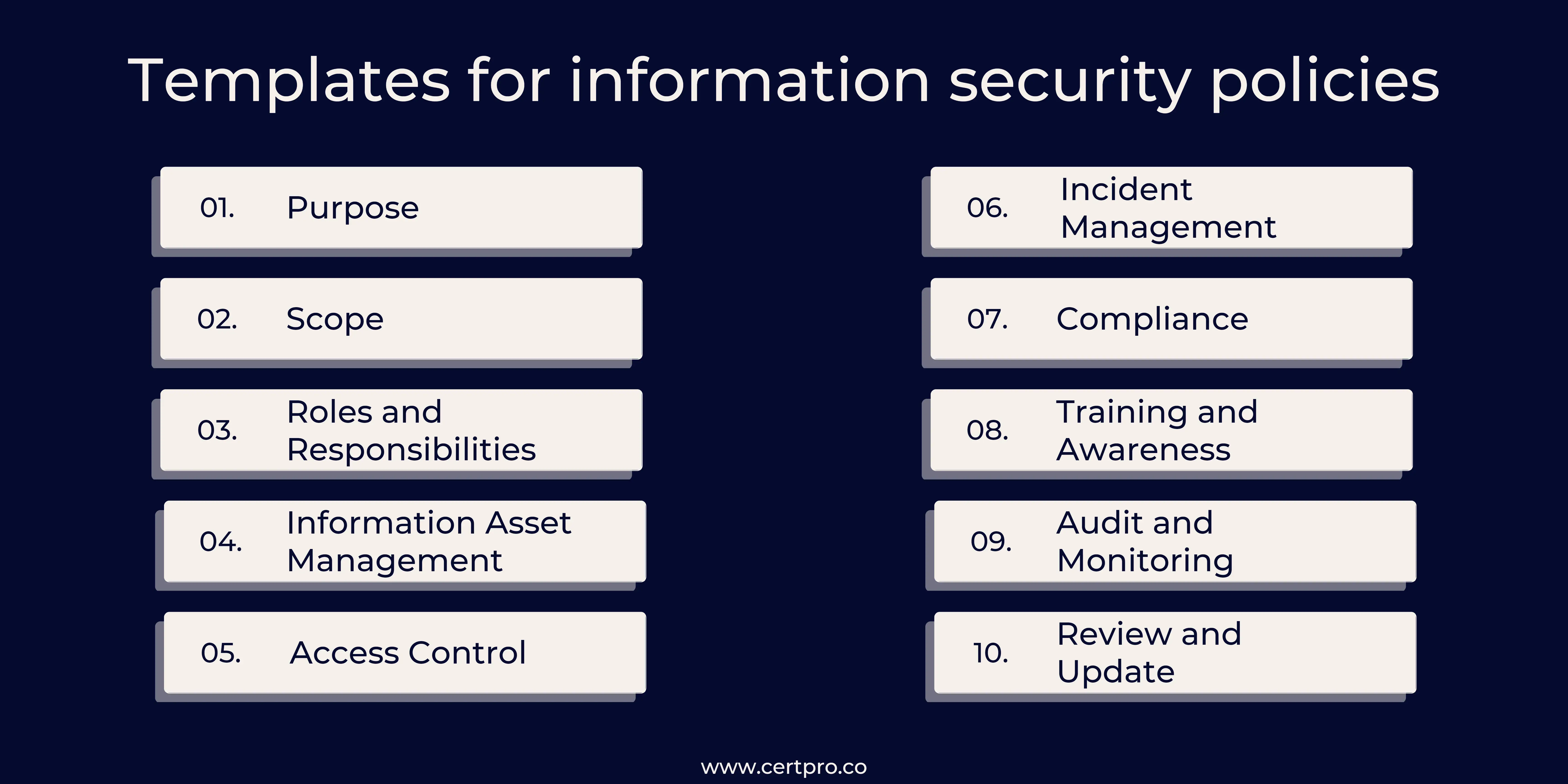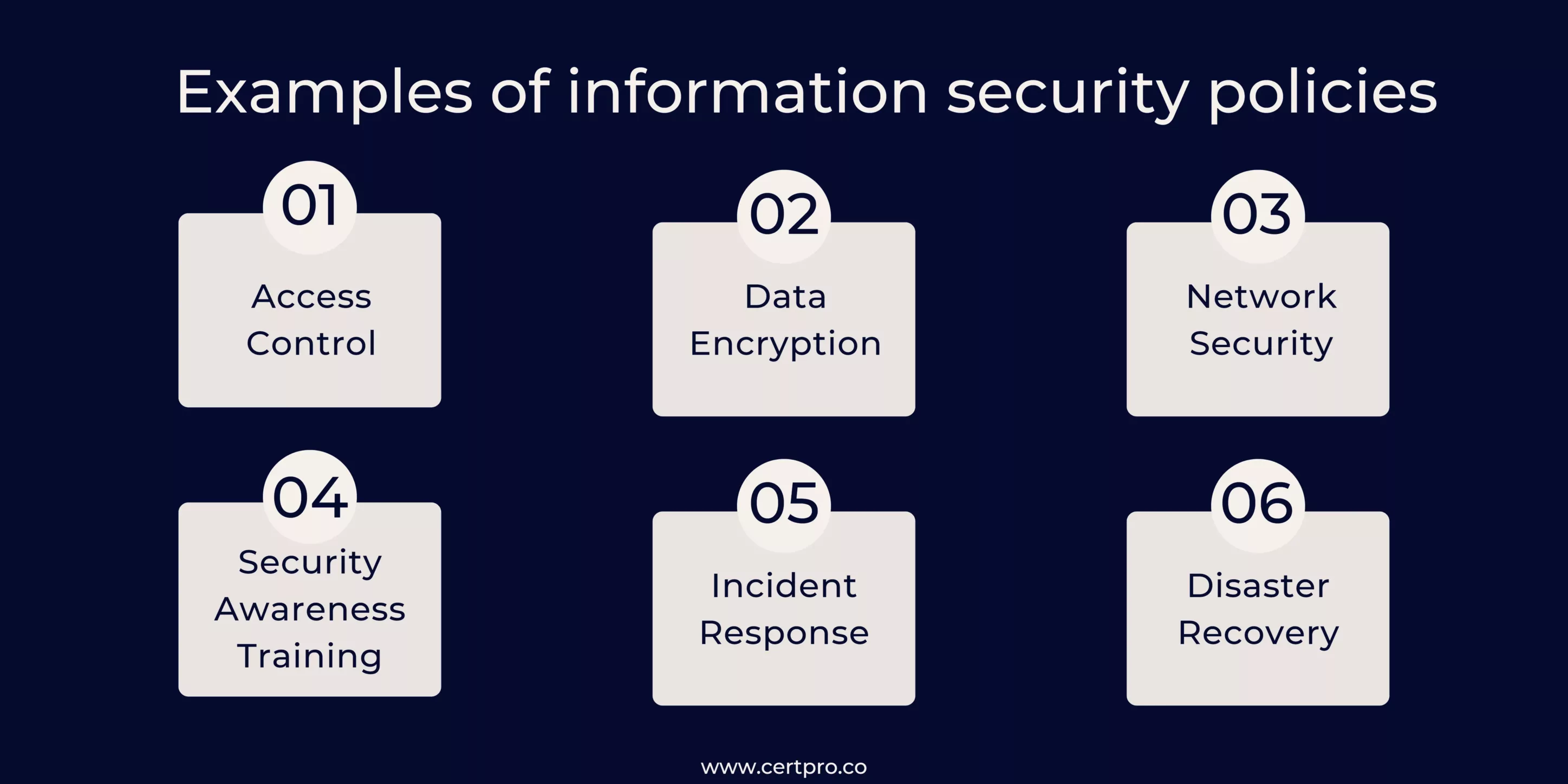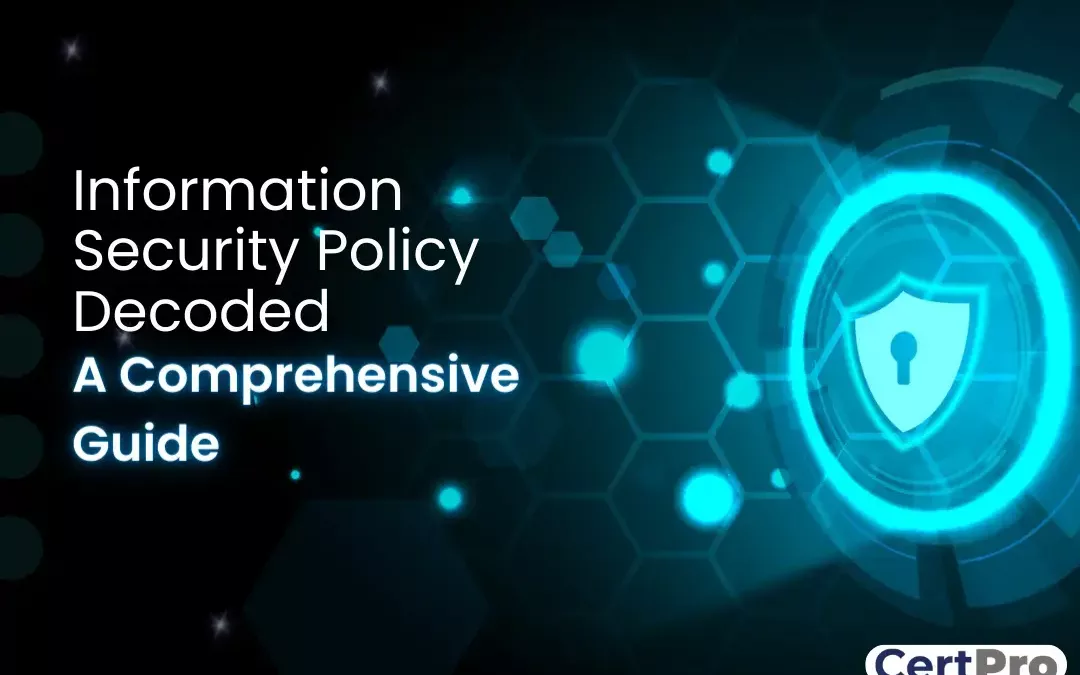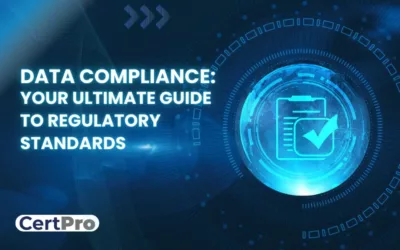In today’s digital world, information is the lifeblood of businesses. With the exponential growth of technology, information security has become a prime concern for all organizations. An information security policy is a critical document that outlines an organization’s approach to protecting confidential and sensitive information. In this, we will decode what information security policies are, what they entail, and provide information security policy examples and templates.
WHAT ARE THE MAIN PRINCIPLES OF INFORMATION SECURITY?
WHAT ARE INFORMATION SECURITY POLICIES?
WHY IS AN INFORMATION SECURITY POLICY IMPORTANT?
TEMPLATES FOR INFORMATION SECURITY POLICIES
EXAMPLES OF INFORMATION SECURITY POLICIES
HOW CERTPRO CAN ASSIST IN DEVELOPING AND IMPLEMENTING COMPLIANT INFORMATION SECURITY POLICIES
What is information security?
Information security refers to safeguarding data against unauthorized access, use, disclosure, disruption, modification, or destruction, whether it be digital or non-digital. It involves the use of various techniques, technologies, and processes to ensure that information assets are secure and available only to authorized users. Information security encompasses a wide range of activities, including risk assessment, vulnerability management, access control, encryption, incident response, and disaster recovery. It applies to all forms of information, including electronic, physical, and verbal, and is critical to protecting an organization’s reputation, customer trust, and financial stability. Effective information security requires a holistic approach, including policies, procedures, and technical controls, to identify, assess, and mitigate security risks to protect sensitive information from internal and external threats.
What are the main principles of information security?
The main principles of information security are confidentiality, integrity, and availability, commonly referred to as the “CIA triad.” These principles are the foundation of information security and help to ensure that information is protected from unauthorized access, alteration, or destruction.
Confidentiality:
Confidentiality ensures that information is kept secret and only accessible to authorized persons. It ensures that sensitive information is not disclosed to unauthorized persons and that access to such information is limited only to those who require it.
Integrity:
Integrity ensures that information is accurate and reliable. It guarantees that the information is accurate and trustworthy and that no unauthorized individuals have modified or altered it.
Availability:
Availability is the principle that information should be accessible to authorized persons when they need it. Availability ensures that information is available to those who require it and that the information is accessible and usable when needed.
These principles work together to protect information and ensure that it remains secure. Confidentiality and integrity work together to protect the privacy and accuracy of the information, while availability ensures that authorized users can access the information when needed.
In addition to the CIA triad, other important principles of information security include authentication, authorization, non-repudiation, and accountability. These principles further enhance the security of information, ensure that only authorized persons have access to specific information, and hold individuals accountable for their actions.
What are information security policies?
An information security policy is a document that outlines an organization’s approach to protecting sensitive and confidential information. It serves as a guide for the employees of the organization on how they should handle, store, transmit, and dispose of the company’s sensitive data. The policy should also detail the measures taken by the organization to prevent unauthorized access, use, disclosure, modification, or destruction of its data.
An information security policy should cover all aspects of the organization’s information security. This includes access control, network security, data encryption, security awareness training, incident response, and disaster recovery. The policy should also cover the roles and responsibilities of employees in maintaining the security of the company’s information.
Why is an information security policy important?
The importance of an information security policy lies in its ability to help an organization achieve the following:
- Protect its sensitive information from internal and external threats.
- Comply with regulatory requirements and industry standards for information security.
- Establish clear guidelines and expectations for employees and contractors regarding information security practices.
- Provide a framework for risk management and incident response.
- Increase awareness of the importance of information security throughout the organization.
By implementing an information security policy, an organization can minimize the risk of data breaches, cyberattacks, and other security incidents. It can also reduce the likelihood of legal liability and reputational damage resulting from a security incident. Ultimately, an information security policy helps an organization safeguard its most valuable asset—its information—and ensure the confidentiality, integrity, and availability of that information.
Templates for information security policies
Developing an information security policy can be a complex process that requires input from different stakeholders within the organization. However, there are many information security policy templates available online that can be used as a starting point. These templates provide a framework that can be customized to fit the specific needs of an organization.
However, here are some key sections that are commonly included in information security policy templates:

1. Purpose: This section outlines the overall objective of the policy and explains why it is important for the organization to have an information security policy.
2. Scope: This section explains the policy’s scope and lists the information assets, personnel, independent contractors, and third-party vendors that the policy covers.
3. Roles and Responsibilities: This section outlines the roles and responsibilities of individuals within the organization concerning information security, including the Information Security Officer, employees, contractors, and third-party vendors.
4. Information Asset Management: This section describes how the organization identifies, classifies, and protects information assets. It may include guidelines for handling confidential information, such as personally identifiable information (PII) and protected health information (PHI).
5. Access Control: This section outlines the procedures for granting and revoking access to information assets. It includes guidelines for user authentication, password management, and access controls.
6. Incident Management: This section outlines the procedures for detecting, reporting, and responding to security incidents. It includes guidelines for incident response, incident reporting, and investigation, and defines the roles and responsibilities of individuals involved in incident management.
7. Compliance: This section outlines the organization’s compliance requirements regarding information security, including relevant laws, regulations, and industry standards.
8. Training and Awareness: This section describes the organization’s training and awareness program for information security. It includes guidelines for employee training, awareness campaigns, and phishing awareness programs.
9. Audit and Monitoring: This section outlines the procedures for auditing and monitoring information security controls. It includes guidelines for monitoring security logs, network traffic, and system activity.
10. Review and Update: This section outlines the procedures for reviewing and updating the information security policy. It includes guidelines for regular review and revision of the policy to ensure that it remains effective and up-to-date.
Examples of information security policies
Information security policies are unique to each organization, and they can vary depending on the size, industry, and regulatory requirements. However, some common elements should be included in all information security policies. Here are some examples of information security policies:

- Access Control: The policy should define who has access to the company’s sensitive data and the level of access they have. It should also detail how access is granted, monitored, and revoked.
- Data Encryption: The policy should define the encryption standards used to protect the company’s sensitive data, such as AES or RSA. It should also detail how encryption is implemented and managed.
- Network Security: The policy should detail the measures taken to secure the organization’s network infrastructure, such as firewalls, intrusion detection and prevention systems, and virtual private networks (VPNs).
- Security Awareness Training: The policy should detail the training programs provided to employees to educate them on information security best practices, such as how to identify and report security incidents.
- Incident Response: The policy should detail the steps to be taken in the event of a security breach, including incident reporting, containment, investigation, and recovery.
- Disaster Recovery: The policy should detail the measures taken to recover from a catastrophic event that may cause the loss of critical data, such as backups, data recovery procedures, and alternate processing sites.
How CertPro can assist in developing and implementing compliant information security policies
An information security policy is a critical component of compliance with these regulations and standards. It provides a framework for ensuring the confidentiality, integrity, and availability of an organization’s information assets and helps to identify, assess, and manage risks to those assets. CertPro can assist organizations in developing and implementing information security policies that are tailored to their specific needs and compliant with applicable regulations and standards. This can help the organization minimize the risk of data breaches, cyber-attacks, and other security incidents, as well as reduce the likelihood of legal liability and reputational damage resulting from a security incident.
An information security policy is essential for compliance with regulations and standards for information security. CertPro can provide valuable assistance in developing and implementing information security policies that meet these requirements and help organizations safeguard their sensitive information.
FAQ
What is the difference between an information security policy and an information security program?
An information security policy (ISP) is a set of rules and guidelines that an organization establishes to govern the use and protection of its information assets. An information security program (ISP), on the other hand, is a comprehensive and ongoing process that includes the development, implementation, and maintenance of information security policies, procedures, and practices to protect an organization’s information assets. The ISP is the operational implementation of those policies and guidelines.
What are the consequences of not having an effective information security policy?
The consequences of not having an effective information security policy can be severe. It may lead to unauthorized access to sensitive information, loss of data, damage to the organization’s reputation, legal and regulatory compliance issues, financial losses, and disruption to business operations. This can have far-reaching consequences, including loss of revenue, loss of customer trust, and potential legal liabilities.
What are some common mistakes to avoid when developing an information security policy?
Some common mistakes to avoid when developing an information security policy include:
- Failing to involve key stakeholders in the development process
- Writing a policy that is too vague or too prescriptive
- not providing adequate training and education to employees
- Failing to regularly review and update the policy to ensure it remains relevant and effective
- failing to align the policy with business objectives and risk appetite.
By avoiding these common mistakes, organizations can ensure that their information security policy is effective and helps protect sensitive information from cyber threats.
How can an organization ensure that its ISP is effective?
An organization can ensure that its ISP is effective by regularly reviewing and updating the policy to reflect changes in the threat landscape or business objectives. It should also provide ongoing training and education to employees to ensure that they understand their roles and responsibilities in maintaining information security. Additionally, the organization should regularly test its security controls and incident response procedures to identify areas for improvement.
How often should an ISP be reviewed and updated?
An ISP should be reviewed and updated regularly to reflect changes in the threat landscape, business objectives, or regulatory requirements. Some organizations may choose to conduct an annual review, while others may review and update their ISP on a quarterly or semi-annual basis.

About the Author
SUBBAIAH KU
Subbaiah Ku is the Regional Director for CertPro in Oman, bringing a wealth of expertise in process and system auditing. As a seasoned lead assessor, Subbaiah is dedicated to ensuring the highest standards in compliance and security. His unique blend of technical acumen, rooted in Mechanical Engineering, is complemented by a diverse range of certifications and extensive training.
EUROPEAN UNION’S ARTIFICIAL INTELLIGENCE ACT: HOW THIS GROUNDBREAKING LAW AFFECTS YOUR BUSINESS
Nowadays, Artificial Intelligence (AI) is transforming our lives exceptionally well. AI is now streamlining healthcare services, providing virtual assistance, and fulfilling queries. Technologies have boons and curses. Similarly, AI creates many concerns about...
How to Implement GRC Frameworks in 2024: Step-by-Step Guide
The rapidly evolving business environment, complexity, and accountability enhance the importance of the organization's governance, risk management, and compliance initiatives. Therefore, if your company finds difficulties expanding, recheck your organization's...
Data Compliance: Your Ultimate Guide to Regulatory Standards
Data compliance involves finding the relevant guidelines related to data protection and storage. Therefore, it creates policies and procedures to secure the data from unauthorized access and prevent the risk of cyber threats. Furthermore, it assures a high-standard...




